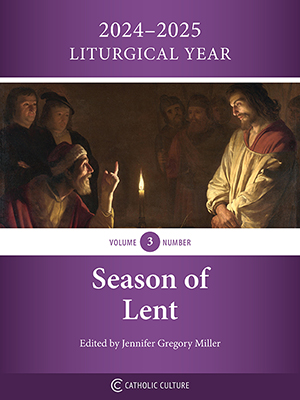The Courage to Live
By Thomas V. Mirus ( bio - articles - email ) | Feb 06, 2014 | In Reviews
For all the popularity in pro-life rhetoric of the phrases “culture of life” and “culture of death,” it seems as though the majority of words in pro-life literature have been spent making moral and political arguments against abortion, rather than exploring the meaning of “culture” and “life.” But abortion is a symptom of a deeper ailment which, in the sphere of literature, must be addressed by examining the cultural atmosphere in which abortion seems like a solution to so many, and by promoting a positive vision of culture and of life in which it would be seen rightly not just as an undesirable solution, but as no solution at all. Such a critique of culture was made, and a vision of life lovingly set forth, in Blessed Pope John Paul II’s encyclical Evangelium Vitae, which is referenced throughout a new book exploring similar themes: Culture and Abortion by Edward Short. This is Short’s third book, following closely after two works on Blessed John Henry Newman.
Free eBook:

|
| Free eBook: Liturgical Year 2024-2025, Vol. 3 |
Though the book includes two chapters on the political history of abortion, notably the final essay, “Abortion and the Historians,” the bulk of Culture and Abortion is spent examining various historical and literary figures – Chesterton, Dickens, William Wilberforce, Walker Percy, Bl. Pope John Paul II and Rose Hawthorne chief among them – who present us with a vision of life that stands profoundly at odds with abortion and the utilitarian ideology on which it rests. Occasionally this is done by focusing on a negative example, as in the lengthy introduction critiquing Matthew Arnold’s notion of culture, in which literature was the highest value. In another chapter, Short uses the testimony of writers of the time to rehabilitate motherhood in Georgian England from the gloomy picture painted by modern feminist historians who have reduced pregnancy to oppression, and childbirth and the raising of children to so many patriarchal social conventions.
For the most part, however, the book is devoted to positive examples, both historical and literary. On the literary side, Short’s chapters on Dickens and on the 20th-century poet Anne Ridler are most successful in presenting a compelling vision of life and childbirth as worthwhile amid all their sufferings and difficulties. However, I found the two most inspiring essays to be those on William Wilberforce and Rose Hawthorne. There is a clear parallel between Wilberforce, a former slave trader whose life became dedicated to ending slavery, and such modern figures as Bernard Nathanson, the abortionist and abortion activist who had a change of heart and became one of the pro-life movement’s greatest leaders. Wilberforce’s perseverance and eventual victory in dismantling a social institution far older and more entrenched than abortion should help us resist the despair which, Short notes, “always threatens the pro-life movement.”
Rose Hawthorne, daughter of Nathaniel Hawthorne, Catholic convert, and founder of the Dominican Sisters of Hawthorne, is another sterling example of concern for all human life, especially those who, in the words of one incurable cancer patient treated by the Sisters, are treated by “everyone else…as throwaways.” Short’s account of Rose Hawthorne’s upbringing, conversion and life as Mother Alphonsa and of the works of mercy continued by her Sisters after her death is the most moving chapter in the book.
In writing a book which has abortion in the title, yet devotes several chapters to literary figures in relation to whom legalized abortion would be an anachronism, Short courts the danger of producing long, interesting passages about this or that nineteenth-century poem or work of fiction, occasionally interspersed with comments to the effect of, “This, of course, is totally contrary to abortion!” To avoid this tedious pattern requires some effort, and here the author has our sympathies, given that the only thing a healthy culture and abortion have in common is that the two have nothing to do with one another. Short is trying to direct our attention to a life-affirming vision of culture, one in which abortion has no place, so it is no surprise that at times the only way abortion can be brought into the picture is by way of contrast.
Even so, the contrasts drawn by Short are occasionally of a dubious nature. For example, in a chapter entitled “What English Literature Would Be like if Pro-Abortion,” he writes that “Dickens would never have written Oliver Twist (1838) because his pro-abortion audience would never have stood for Oliver’s mother dying so that Oliver might live.” If so, how are we to explain the massive popularity today of the Harry Potter books and films, the whole plot of which depends upon Harry’s mother doing the exact same thing? Clearly, then, Short’s depiction of the pro-abortion viewpoint is, while logically sound, an abstraction that does not match the views of many, probably most, people today who would call themselves “pro-choice.” As much as we pro-lifers (or anti-abortionists, as the case may be) scoff at that moniker, it is nonetheless true that most people who believe abortion should be legal are not pro-abortion per se, and would never contend that abortion is the only legitimate solution when a mother’s life is in danger, or that there is nothing to be praised in a mother’s self-sacrificing love. This is the position of the most extreme abortion advocates only, and we have reason to hope that the more their views are exposed to the general public, the less comfortable will the public be with accepting abortion at all. By and large, abortion is tolerated because its ugly reality is swept under the rug; for most people it is still an unpleasant topic, and only the most perverted can see it for what it is and embrace it nonetheless.
Edward Short’s book is not for those who are looking for more arguments or strategies. That is its greatest strength, even amid its imperfections. The pro-life movement has no shortage of arguments and strategies, but as Pope Francis has said many times, these are useless if people do not believe that life is worth living. It is no good making a moral argument to one who is demoralized. An approach both broader and more fundamental is needed – a new vision of life, along with a new dose of courage, hope and inspiration. At its best, Culture and Abortion is neither a shrewd political tract nor a groundbreaking moral treatise, but a testament to the glory of human life even in its most squalid poverty, an exhortation to love our neighbor, and for the pro-life movement, a reminder that victory is possible.
All comments are moderated. To lighten our editing burden, only current donors are allowed to Sound Off. If you are a current donor, log in to see the comment form; otherwise please support our work, and Sound Off!
-
Posted by: John J Plick -
Feb. 17, 2014 10:30 AM ET USA
There are few laws that are so hard and fast that any number of legitimate options contradictory to that law are not allowed. An exhaustive view of law has been used against us in that you find the unusual exception(s), you emphasize "those," thus reversing the law out of "compassion" while at the same time allowing a flood of illegitimate "exceptions" to occur. We as "prescriptionist" Catholics tend to emphasize "the law" over grace. Wisdom is one of the requirements for abortion to stop.
-
Posted by: John J Plick -
Feb. 17, 2014 10:20 AM ET USA
In a Church where poverty, disease and any other kind of affliction are being elevated in importance over eternal life with God it is easy to see how "the Culture of Death" has gained the advantage. We have "crosses" displayed, we make "the sign of the cross" but as far as practically living out suffering with the Cruxified, we are failing miserably.







